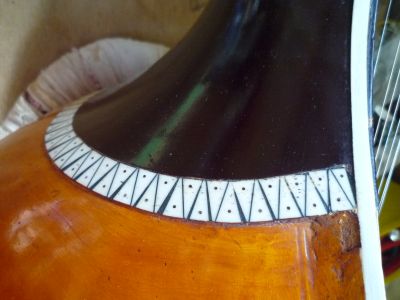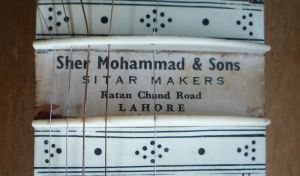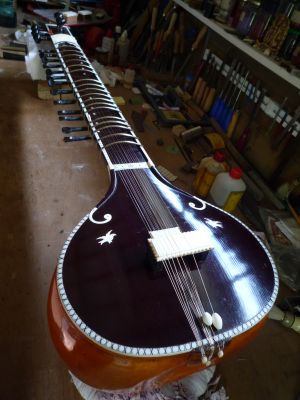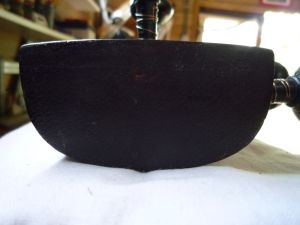Sher Mohammad vintage sitar
This sitar was made in the “Sher Mohammad & Sons Sitar Makers”- shop in Bansanwala Bazaar, Lahore 1940 – 1950 by early sitarmaker Sher Mohammed. At that time, before the Partition, he taught sitar making to, amongst others, Rikhi Ram Sharma and Kartar Chand Sharma. At Partition time, both Rikhi Ram Sharma and Kartar Chand Sharma left Lahore and headed for Delhi where they both settled their own sitar shop (only 800 m. away from each other). Rikhi Ram’s shop became world famous due to Ravi Shankar and the Beatles. Kartar Chand, joined by his younger brother Hari Chand, remained low profile and continued making high quality professional sitars at Paharganj. They developed their own style of sitars and got specialised in repair work. Amongst their main customers was late Pt. Balaram Pathak, and his son Ashok Pathak. In januari 1993 Kartar Chand passed away, and thus leaving the shop to his brother Hari Chand.
The original stringing (before main artists commenced to change details as per their own requirements) put on this sitar is:
Main strings gauges :
1) Baj tar : steel, 0,28mm (N°2) or 0,30mm (N°3)
2) & 3) Jora tar : brass, 0,37mm (N°28) or 0,40mm (N°27)
4) Pancham tar : brass, 0,37mm (N°28) or 0,40mm (N°27)
5) Pancham tar : steel, 0,28mm (N°2) or 0,30mm (N°3)
6) & 7) Cikari tar : steel, 0,21mm (N°00) or 0,23mm (N°0)
Taravs : steel, 0,21mm (N°00) or 0,23mm (N°0)
REMARK: Depending on style and/or raga the 4th string should change.
In the rare situation you are using a DHA/NI (= A#/B#) then the original string gauge can be used. However, in a more appropriate tuning, when the string’s pitch is raised to GA (= E#) this brass string tends to break easily. So, nowadays, a steel string, 0,28mm (N°2) or 0,30mm (N°3) is used more commonly.
Also, in my personal experience with Hari Chand, since long time the brass strings (#2-3-4) aren’t used any more. They are replaced by bronze, which alloy is much stronger and has a warmer sound.
Practical tuning of the 7 main strings is:
1) tuned to MA (F#) : steel, 0,28mm (N°2) or 0,30mm (N°3)
2) & 3) tuned to SA (C#) : bronze, 0,37mm (N°28) or 0,40mm (N°27)
4) tuned to GA (E#) : steel, 0,28mm (N°2) or 0,30mm (N°3)
5) tuned to PA (G#) : steel, 0,28mm (N°2) or 0,30mm (N°3)
6) & 7) tuned to SA (C#) : steel, 0,21mm (N°00) or 0,23mm (N°01)
 This sitar has very simple decoration, old style round kutis and a beautiful tumba. Also note that the cikari kutis are not different from the tarav kutis. The shape of the neck is rather rectangular and this tiny instrument is ultra lightweight… Very special on this sitar is that the tabli is made of spruce wood. The sound of this sitar is particularly clear, warm and with a strong tarav response.
This sitar has very simple decoration, old style round kutis and a beautiful tumba. Also note that the cikari kutis are not different from the tarav kutis. The shape of the neck is rather rectangular and this tiny instrument is ultra lightweight… Very special on this sitar is that the tabli is made of spruce wood. The sound of this sitar is particularly clear, warm and with a strong tarav response.
See this article about musical heritage: “The last of the sitar makers” by Sonia Malik, published in The Express Tribune, 24/09/2011.




I need some spare parts of the sher muhammad made sitar. I am from Peshawar. how can i get it. please provide me a contact no of their lahore shop. I also need one Sarod. thanks
I am sorry, dear Masud, but I do not have any contact information about their shop…
Hi, i have the same model, bought in 1975. What can be its price? Thank you very much
I don’t know for sure but I guess that they are not expensive. At that time many were made. They were all small simple student sitars without decoration…
could you pl provide telephone and contact details of sher mohammad sittar maker in Bansanwala Bazzar lahore
I have owned 3 Sher Mohammed sitars and each was wonderful. Although simple in design they were very well made and played and sounded beautiful. The old style neck top is flat under the pardahs. This is the design I liked and used on the 2 sitars I built.
It seems that the workshop is still building in Lahore and I hope that they still make such lovely instruments.
Thank you for pointing me to some remark I should add concerning the 4th string.
Depending on style and/or raga the 4th string should change.
In the rare situation you are using a DHA/NI (= A#/B#) then the original string gauge can be used. However, in a more appropriate tuning, when the string’s pitch is raised to GA (= E#) this brass string tends to break easily. So, nowadays, a steel string, 0,28mm (N°2) or 0,30mm (N°3) is used more commonly.
Also, in my personal experience with Harichand, since long time the brass strings (#2-3-4) aren’t used any more. They are replaced by bronze, which alloy is much stronger and has a warmer sound.
Practical tuning of the 7 main strings is:
1) tuned to MA (F#) : steel, 0,28mm (N°2) or 0,30mm (N°3)
2) & 3) tuned to SA (C#) : bronze, 0,37mm (N°28) or 0,40mm (N°27)
4) tuned to GA (E#) : steel, 0,28mm (N°2) or 0,30mm (N°3)
5) tuned to PA (G#) : steel, 0,28mm (N°2) or 0,30mm (N°3)
6) & 7) tuned to SA (C#) : steel, 0,21mm (N°00) or 0,23mm (N°01)
Hi.
So the Sher M. sitar has the same thickness in string #2-3-4: could you hint at the TUNING of the 7 main strings?
Thanks again.
ML.